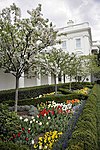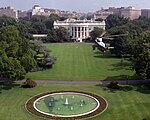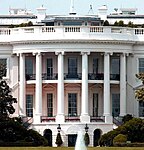Situation Room

The Situation Room, officially known as the John F. Kennedy Conference Room, is a 5,525-square-foot (513.3 m2) conference room and intelligence management center in the basement of the West Wing of the White House. It is run by the National Security Council staff for the use of the president of the United States and his advisors (including the national security advisor, the homeland security advisor and the White House chief of staff) to monitor and deal with crises at home and abroad and to conduct secure communications with outside (often overseas) persons. The Situation Room is equipped with secure, advanced communications equipment for the president to maintain command and control of U.S. forces around the world.
Excerpt from the Wikipedia article Situation Room (License: CC BY-SA 3.0, Authors, Images).Situation Room
West Executive Avenue Northwest, Washington
Geographical coordinates (GPS) Address Nearby Places Show on map
Geographical coordinates (GPS)
| Latitude | Longitude |
|---|---|
| N 38.897 ° | E -77.037 ° |
Address
Putting Green
West Executive Avenue Northwest
20503 Washington
District of Columbia, United States
Open on Google Maps











